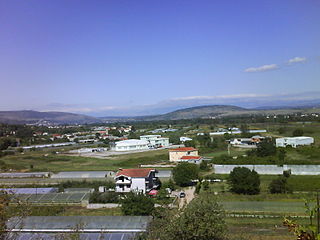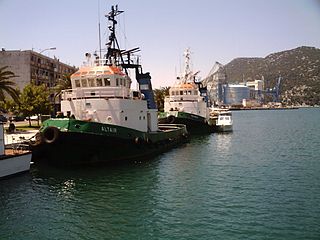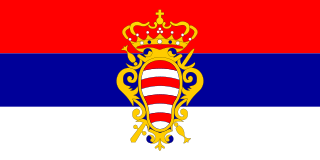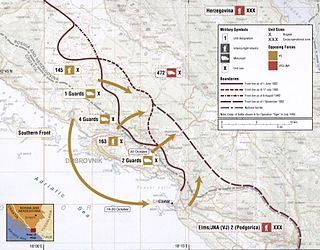
The Herzegovina-Neretva Canton is one of 10 cantons of the Federation of Bosnia and Herzegovina in Bosnia and Herzegovina.

The Dubrovnik-Neretva County is the southernmost county of Croatia. The county seat is Dubrovnik and other large towns are Korčula, Metković, Opuzen and Ploče. The Municipality of Neum, which belongs to neighbouring Bosnia and Herzegovina, divides the county in two parts which are connected only by the Pelješac Bridge. The southern part of the county consists of Dubrovnik and the surrounding area, including the Pelješac peninsula, and the islands of Korčula, Lastovo, Mljet, Šipan, Lopud and Koločep. The northern part of the county includes the Neretva Delta, the Baćina lakes north of Ploče, and a swath of hinterland near the southernmost slopes of Biokovo and around the hill of Rujnica. The northern part of the Mljet island is a national park. The Lastovo archipelago is a designated nature park. The southernmost tip of the county is the Prevlaka peninsula at the border with Montenegro. It is the only Croatian county that borders Montenegro.

Neum is a town and municipality in Bosnia and Herzegovina, located in Herzegovina-Neretva Canton of the Federation of Bosnia and Herzegovina. It is the only town on the Bosnia and Herzegovina coastline, making it the country's only access to the Adriatic Sea. As of 2013, Neum municipality has a population of 4,653 inhabitants, while the town of Neum has a population of 3,013 inhabitants.

Ploče is a town and seaport in the Dubrovnik-Neretva County of Croatia.

Pelješac is a peninsula in southern Dalmatia in Croatia. The peninsula is part of the Dubrovnik-Neretva County and is the second largest peninsula in Croatia. From the isthmus that begins at Ston, to the top of Cape Lovišta, it is 65 km or 40 mi long.

Dubrovačko Primorje is municipality situated northwest of the city Dubrovnik in Dubrovnik-Neretva County in southern Croatia. The municipality's borders extend all the way up to Neum, Bosnia and Herzegovina. The center of the municipality is the village of Slano. Dubrovačko Primorje is underdeveloped municipality which is statistically classified as the First Category Area of Special State Concern by the Government of Croatia.

The Pelješac Bridge is a cable-stayed bridge in Dubrovnik-Neretva County, Croatia. The bridge provides a fixed link from the southeastern Croatian semi-exclave to the rest of the country while bypassing Bosnia and Herzegovina's short coastal strip at Neum. The bridge spans the sea channel between Komarna on the northern mainland and the peninsula of Pelješac, thereby passing entirely through Croatian territory and avoiding any border crossings with Bosnia and Herzegovina at Neum.

European route E73 forms part of the United Nations International E-road network, connecting Hungary and eastern Croatia to Bosnia and Herzegovina and the Adriatic Sea in the vicinity of the port of Ploče. This 679-kilometre (422 mi) route is also designated as the Pan-European Corridor Vc, a branch of the fifth Pan-European corridor. The route largely consists of two-lane roads with at-grade intersections, although in the 2000s, about a third of the route was upgraded to motorway standards. The remainder of the route is currently being upgraded in all the countries spanned. The longest part of this corridor goes through Bosnia and Herzegovina and is widely touted as a road instrumental to the development of the country. The road also serves as the shortest connection of the eastern and southern parts of Croatia.

The Adriatic Highway is a road that stretches along the eastern coast of the Adriatic Sea and is part of the European route E65. The road passes through Croatia, with smaller stretches through Bosnia and Herzegovina and Montenegro and ends at the Montenegro-Albania border. It is an undivided two-lane road for almost its entire length, with the exception of a short stretch through Zadar and a 24 kilometres (15 mi) dual-carriageway section from Plano (Trogir) to the southeast suburbs of Split. It was planned in the 1930s and built in the 50s and 60s. The dual carriageway is planned to be extended further southeast to Omiš. Completion of the Adriatic Ionian motorway is proposed in order to replace the Adriatic highway as a high-performance road transport route along the Adriatic coast.

The A1 motorway is the longest motorway in Croatia, spanning 476.3 kilometers (296.0 mi). As it connects the nation's capital Zagreb to the second largest city Split, the motorway represents a major north–south transportation corridor in Croatia and a significant part of the Adriatic–Ionian motorway. Apart from Zagreb and Split, the A1 motorway runs near a number of major Croatian cities, provides access to several national parks or nature parks, world heritage sites, and numerous resorts, especially along the Adriatic Coast. National significance of the motorway is reflected through its positive economic impact on the cities and towns it connects as well as its importance to tourism in Croatia.

Gabela is a village in southern Bosnia and Herzegovina, 5 kilometres south of Čapljina and 4 kilometers from Metković, in Croatia. It is situated in the navigable lower course of the Neretva, off the major road linking the coast with the mountainous hinterland.

The D8 state road is the Croatian section of the Adriatic Highway, running from the Slovenian border at Pasjak via Rijeka, Senj, Zadar, Šibenik, Split, Opuzen and Dubrovnik to the border with Montenegro at Karasovići. Most of the D8 state road remains single carriageway, though with some dual carriageway stretches. The total length of the road through Croatia is 643.1 kilometres (399.6 mi).

Herzegovina is the southern and smaller of two main geographical regions of Bosnia and Herzegovina, the other being Bosnia. It has never had strictly defined geographical, cultural or historical borders, nor has it ever been defined as an administrative whole in the geopolitical and economic subdivision of Bosnia and Herzegovina.

The foreign relations between Bosnia and Herzegovina (BiH) and Croatia are bound together by shared history, language, neighboring geography and cultural commonalties. They established diplomatic relations in 1992, following the dissolution of Yugoslavia and independence of Croatia. The two countries share a 932-kilometer (579 mi) border – the second longest external land border in the European Union (EU). Modern relations between the two states are functional but remain tense after ineffective 21st-century attempts to détente.

Bay of Mali Ston is a bay in the Adriatic Sea, enclosed by the Pelješac peninsula and the mainland. The name primarily refers to the innermost, eastern part of the bay, while the name Channel of Mali Ston is used for the channel between the peninsulas of Klek and Pelješac, in the west. The two bodies of water are located in Croatia's and partly in Bosnia and Herzegovina's territorial waters.

D62 is a state road running parallel to a section of A1 motorway route in Croatia, between Šestanovac, Vrgorac and Mali Prolog, and parallel to the A10 motorway after Mali Prolog. The road provides access to the Mali Prolog border crossing to Bosnia and Herzegovina via the D222 state road.

The Port of Ploče is a seaport in Ploče, Croatia, near the mouth of the Neretva river on the Adriatic Sea coast. It was formally opened in 1945 after a railway was built as a supply route to connect the site with industrial facilities in the Sarajevo and Mostar areas of Bosnia and Herzegovina, which was then part of Yugoslavia. As of 2010, it ranked as the second largest cargo port in Croatia—after the Port of Rijeka—with a cargo throughput of 4.5 million tonnes, consisting mostly of general cargo and bulk cargo, including 20,420 TEU Containers. In 2008, the Port of Ploče recorded 2,555 ship arrivals. It is managed by the Port of Ploče Authority.

The Dubrovnik Republic was a Serb proto-state that existed during the Siege of Dubrovnik in the Croatian War of Independence, self-proclaimed on 15 October 1991 in occupied areas of Croatia, after being captured by members of 2nd Corps of the Yugoslav People's Army (JNA). Its provisional president was Aleksandar Aco Apolonio, who was also the president of the Movement for the Republic of Dubrovnik.

Operation Tiger was a Croatian Army (HV) offensive conducted in areas of Croatia and Bosnia and Herzegovina near Dubrovnik between 1 and 13 July 1992. It was designed to push the Army of Republika Srpska (VRS) away from the city towards Popovo field and secure a supply route via Rijeka Dubrovačka, which was gained in early June as the siege of Dubrovnik by the Yugoslav People's Army (JNA) was lifted. The operation's success was facilitated by the establishment of the HV's Southern Front command and the successful conclusion of the May–June 1992 operations against the VRS in the Neretva River valley, which concluded with Operation Jackal.

The Sarajevo–Ploče railway is a 194-kilometre (121-mile) long railway in Bosnia and Herzegovina and Croatia. The line connects Sarajevo with Konjic, Mostar and Ploče. The route operates through the regions of Sarajevo Canton, Herzegovina-Neretva Canton and Dubrovnik-Neretva County. The route largely follows the route of the Neretva river. Passenger services along the full length of line have been discontinued between 2013 and 2022, running only between Sarajevo and the town of Čapljina on the Bosnian-Croatian border. International train service between Sarajevo and Ploče resumed on 1 July 2022, on weekends until September 1st, using Spanish-designed Talgo wagons. This service also ran during the summer of 2023. The line is part of the pan-European corridor 5C from Budapest via Osijek and Sarajevo to Ploče. The section through Bosnia and Herzegovina is marked 11, and through Croatia M304.





















